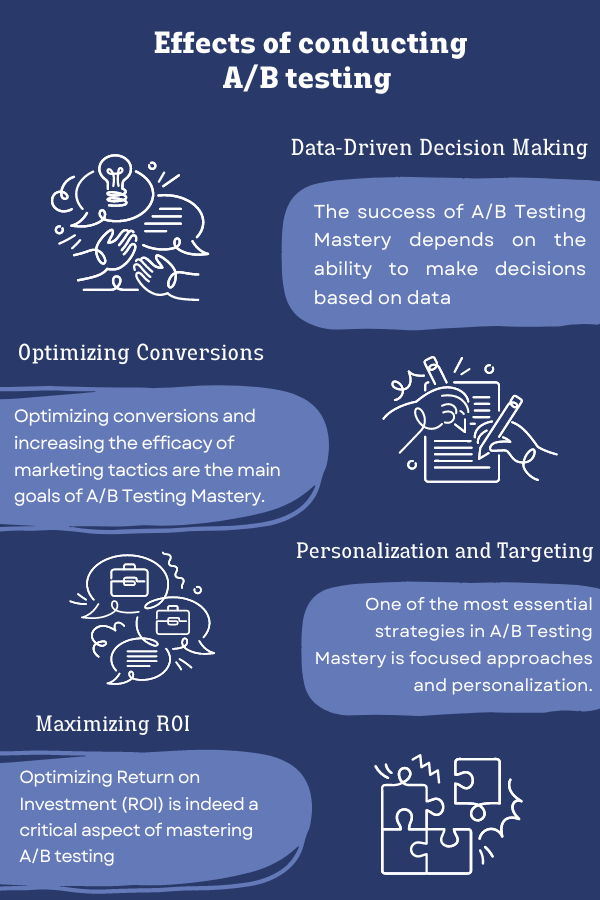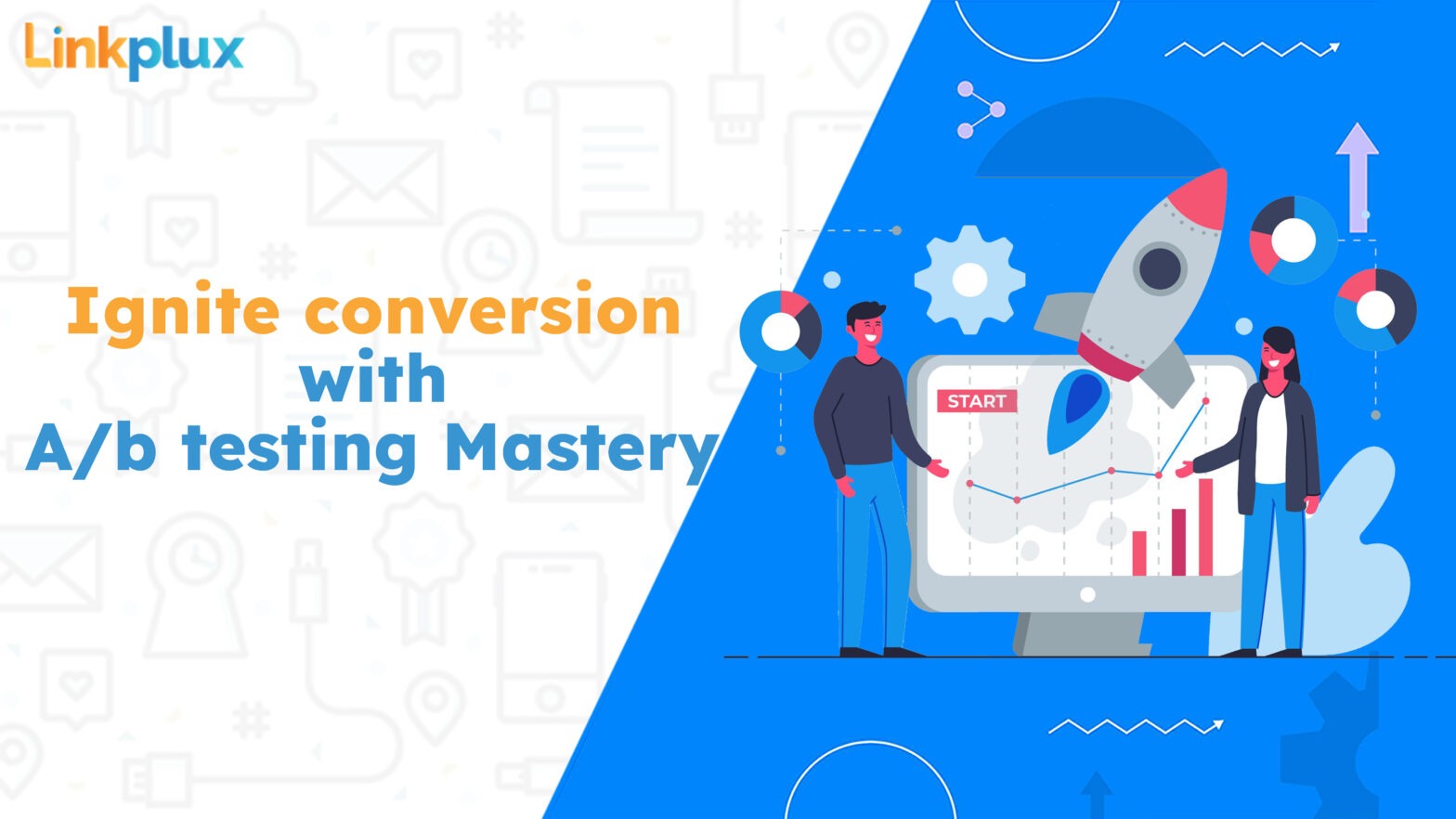A/B testing, often known as split testing, is an essential technique in the fields of internet development and marketing. Businesses can analyze variants in homepage features like headlines and calls-to-action by using specialist AB testing software, like Google AB testing. With this approach, the audience is split into two groups, each of which is shown a different version, and user engagement and conversion rates are examined. Website AB testing is essential for improving content and user experience, and A/B testing marketing tactics allows data-driven decisions to optimize digital initiatives. Businesses can maintain their competitiveness by refining ongoing marketing initiatives and responding to consumer preferences through methodical testing and tracking.
The process of A/B testing:
A/B testing is a systematic procedure comparing two versions (A and B) of a marketing component to ascertain how well they accomplish particular goals. Starting with well-defined objectives, the process includes picking one variable, audience segmentation, and group assignment at random for equitable comparison. Crucial steps include a balanced test duration, accurate variation implementation, and trustworthy data gathering. Conclusions are reached after statistical analysis, and practical insights are included in the broader marketing plan. Iterative testing fosters a culture of continuous improvement, and the documentation of test details makes future reference easier. Additionally, leveraging insights gained from A/B testing can lead to more targeted and personalized approaches, increasing overall campaign effectiveness.
Strategies for Effective A/B Testing in Marketing:
Clear Hypotheses :
Establish precise assumptions or hypotheses on the modifications you anticipate having an influence on your marketing metrics prior to running A/B tests. These could be conjectures on calls to action, imagery, headlines, or other campaign components. Well-defined hypotheses facilitate the testing process and guarantee that you’re concentrating on significant deviations.
One Variable at a Time:
The technique of focusing on and changing just one component or feature of a marketing campaign or website at a time is known as “testing one variable at a time.” With this method, marketers can precisely gauge how that particular modification will affect important performance indicators like click-through rates, conversion rates, or revenue.
Sufficient Sample Size:
Make sure the sample size of your A/B testing is large enough to get findings that are statistically significant. To do this, you usually need to test your variations on a sizable enough subset of your intended audience to identify significant performance differences. Calculators for statistical significance can be used to estimate the sample size required to produce accurate results.
Continuous Monitoring and Iteration:
Keep a close eye on the outcomes of your A/B testing and be ready to make adjustments depending on new information. Instead of settling for a single test, use the results to guide more research and iteratively improve your marketing tactics. Continual experimentation is essential to promoting continual progress in your marketing campaigns because A/B testing is an iterative process.
The Impact of A/B Testing Is Crucial Role in Marketing :
One essential technique in marketing is A/B testing, which is a dynamic way to improve and adjust plans for the best results. Using this technique, two versions of a marketing piece—a webpage or an email—are compared to ascertain whether the version functions better regarding user engagement, conversions, and other essential metrics.

Data-Driven Decision Making:
The success of A/B Testing Mastery depends on the ability to make decisions based on data. Real-time data and empirical evidence from A/B testing tests enable businesses to make well-informed decisions. This approach ensures strategic choices are based on user behavior, preferences, and variance effects rather than supposition.
Optimizing Conversions:
Optimizing conversions and increasing the efficacy of marketing tactics are the main goals of A/B Testing Mastery. Companies can identify the factors that affect user behavior by carefully formulating hypotheses, choosing variables, and utilizing randomization techniques.
Personalization and Targeting:
One of the most essential strategies in A/B Testing Mastery is focused approaches and personalization. While targeting is concerned with delivering messages to particular audience segments, personalization entails adjusting experiences and content to each user’s preferences.
Maximizing ROI:
One of the most important parts of mastering A/B testing is maximizing ROI. Companies can optimize their marketing ROI—investments by carefully developing and improving A/B testing techniques.
Conclusion
A/B Testing Mastery is crucial for optimizing marketing campaigns. Employing dedicated A/B testing software like Google AB Testing is essential. Rigorous goal-setting and an agile mindset, combined with A/B testing marketing strategies, help companies understand user behavior. Incorporating A/B testing website methods ensures continual optimization for user engagement and conversion. The iterative nature of A/B testing, particularly Website A/B testing, allows for data-driven improvements, resulting in more effective campaigns. A/B Testing Mastery stands as a pillar for marketing excellence, emphasizing the significance of specialized tools, strategic execution, and continuous optimization in a dynamic digital environment.
A/B Testing FAQs:
How does A/B testing function in marketing, and what is it?
Split testing, another name for A/B testing, compares two iterations (A and B) of a marketing piece to determine which is more effective. It shows these versions to various audience segments and evaluates the outcomes.What makes A/B testing crucial for marketing strategy optimization?
Because it gives advertisers empirical data on user preferences, A/B testing is essential for making well-informed decisions and optimizing features such as headlines, graphics, and calls-to-action for optimal performance.
Which components are frequently tested in A/B testing campaigns?
Headlines, photos, language, calls-to-action, layout, and color schemes are among the frequently tested elements. Testing these components aids in determining the best mix for accomplishing particular marketing objectives.
How can the statistical significance of the outcomes of an A/B test be ascertained?
A t-test or chi-squared test are two standard statistical tests used to assess statistical significance. Statistical software or online calculators can aid data analysis and determine whether observed differences are statistically significant.
What are the main obstacles and traps to watch out for when doing A/B testing?
The potential for distorted outcomes due to small sample sizes, the impact of outside factors on outcomes, the risk of implementing changes based on statistically insignificant findings, and the misinterpretation of data are some of the obstacles and pitfalls associated with A/B testing. It takes careful thought and reliable techniques to overcome these obstacles and obtain valuable insights from A/B testing.

